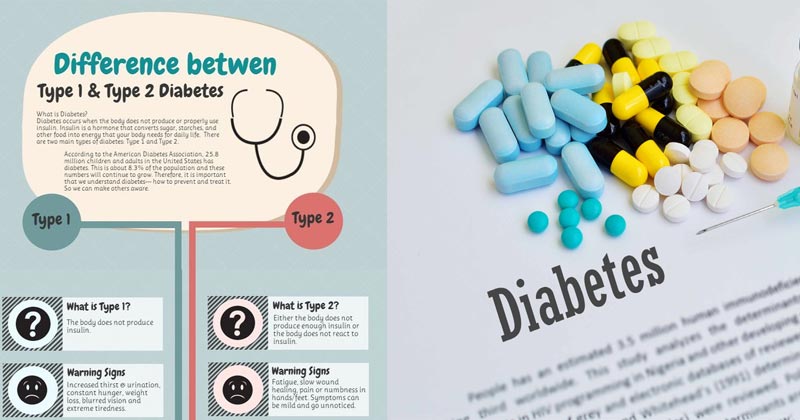Recognizing diabetes mellitus is often not easy. An estimated sixty million Indians are already diabetics today. Our body gives us signals that we usually ignore or take lightly. Today, we will tell you how diabetes is manifesting and how to interpret the signals of your body correctly so you know the signs of diabetes.
What is Diabetes mellitus?
It is a metabolic disease. The endogenous hormone insulin, which is produced in the pancreas, can not be sufficiently produced (Type 1) or is not effective (Type 2). Its main function is to inject the glucose into the human cells, from which the cells gain energy. In diabetes, therefore, the blood sugar level increases, but the body cells are not sufficiently supplied with energy since the glucose remains in the blood. So the sugar or energy balance gets out of control.

In diabetes mellitus, the distinction is majorly made between Type 1 and Type 2. Also, there are some rare special forms, such as LADA or MODI, as well as gestational diabetes.
There are two major types of Diabetes:
Type 1 Diabetes: Signs and Symptoms

Type 1 diabetes starts with most people already in adolescence. It happens because the cells in the pancreas that secrete or make up the hormone insulin are destroyed and the insulin secretion stops. The human body has no other way of making insulin. The person suffering from type 1 diabetes must therefore either inject insulin several times a day or have a pump that delivers insulin into the blood. The disease accompanies diabetics for a lifetime because the dysfunction of the pancreas is irreversible.
Typical symptoms of type 1 diabetes are severe thirst, increased urination, weight loss, feeling of weakness, and low performance.
The Side effect in Children
Diabetes has long become a common disease. According to current estimates by NHP, about sixty million Indians are affected. According to Indian J Endocrinol Metab 2015, India has about 97.700 children with Type 1 Diabetes. Often these children are considered sick because of the regular use of insulin and are asked not to live a normal life. Approximately 20% of the children get isolated and it contributes to something called a ‘Diabetic Distress’.
Type 2 Diabetes: Signs and Symptoms

Type 2 diabetes is the most prevalent form and is also referred to as “aged sugar”. The predisposition to contract type 2 is often hereditary. 60 percent of people whose parents or siblings have diabetes type 2 are likely to become ill during the course of life. However, the cause of the disease of type 2 is not a sub-production of insulin in the pancreas. Rather, the body cells develop insulin resistance, so that they do not absorb enough sugar from the blood. Overweight and lack of exercise promote the “old-age sugar”. Type 2 diabetes is a disease that with proper diet and sports activities can be met.
It can be said about Diabetes Type 2 that it runs in the family because nobody runs in the family.
Symptoms of “old-age sugar” usually come slowly
Symptoms usually occur in people over the age of 40 years. Since the disease is creeping, signs can not be interpreted properly at first. Similar to type 1, those affected feel cut off, have more thirst and a poor general condition. Other warning signs of diabetes may include increased itching, increased susceptibility to infection, frequent dizziness and nausea, and leg cramps and headache. Today, more and more children and adolescents are affected by type 2 diabetes due to unhealthy lifestyle. Insulin works worse in people who are physically inactive. Also remember, you should not fight the signs of diabetes but diabetes itself.
According to estimates by the World Health Organization (WHO), the proportion of diabetics in India is set to rise by 2030. The number of people with Type 2 Diabetes in India is expected to be 98 million. The main reason for the increase in the number of people suffering from the disease is an unhealthy lifestyle, overweight and too little exercise.
Diabetes mellitus type 2 can be prevented. If you have old-age diabetes in your family, or if you are overweight, you should have regular check-ups to help diagnose the condition as early as possible. Only then can you counteract the damage at an early stage. In addition, at-risk people should do sports or at least be active regularly – four hours a week can make a difference. When it comes to nutrition, they should look for a variety of foods that are high in fiber and low in fat.
Vitamin D is also supposed to help prevent diabetes. To increase your vitamin D levels, you can often soak up some sun, as this substance is formed in the body with the help of UV radiation. Overweight diabetics are also often advised to reduce their weight. However, it is debatable whether long-term weight loss is possible for most people.
So, these are the signs of diabetes that you should never ignore and consult a Doctor to live a happy and healthy life.


